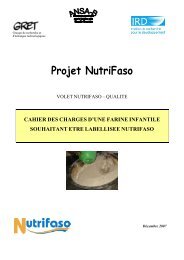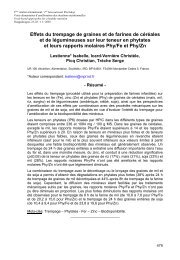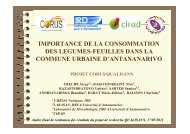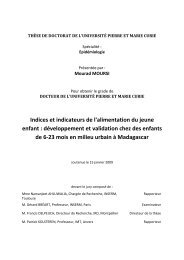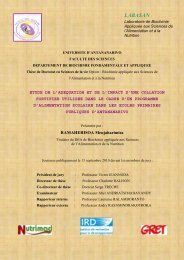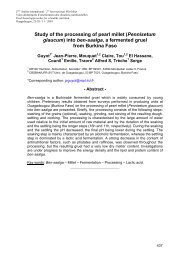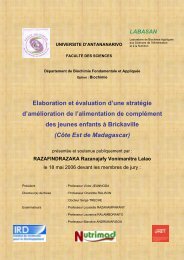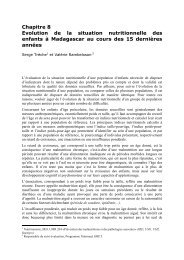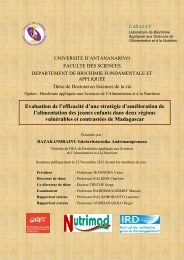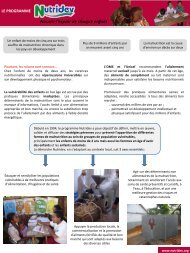THESE UNIQUE El Hassane Kéhien-Piho TOU - Nutridev
THESE UNIQUE El Hassane Kéhien-Piho TOU - Nutridev
THESE UNIQUE El Hassane Kéhien-Piho TOU - Nutridev
Create successful ePaper yourself
Turn your PDF publications into a flip-book with our unique Google optimized e-Paper software.
1566<br />
ARTICLE IN PRESS<br />
E.H. Tou et al. / LWT 40 (2007) 1561–1569<br />
A<br />
mmol/L<br />
B<br />
mmol/L<br />
14<br />
12<br />
10<br />
8<br />
6<br />
4<br />
2<br />
0<br />
140<br />
120<br />
100<br />
80<br />
60<br />
40<br />
20<br />
0<br />
C<br />
mmol/l<br />
D<br />
80<br />
70<br />
60<br />
50<br />
40<br />
30<br />
20<br />
10<br />
0<br />
0 4 8 12 16 20 24 0 4 8 12 16 20 24<br />
mmol/L<br />
80<br />
70<br />
60<br />
50<br />
40<br />
30<br />
20<br />
10<br />
0<br />
Fermentation time (h)<br />
Fermentation time (h)<br />
Fig. 4. Changes in sugar concentrations (J: glucose, ’: fructose, n: melibiose and m: maltose) in MG-T (A) and MG-CMI (B), and in ethanol, lactate<br />
and acetate concentrations (B: lactate, E: ethanol and n: acetate) in MG-T (C) and MG-CMI (D) in supernatant of pastes during the fermentation step.<br />
Bars indicate standard deviation.<br />
resulted in a slight decrease in pH from 4.7 to about 4.0.<br />
The combined effects of the decrease in pH to under 4.5<br />
with the production of antimicrobial compounds by LAB<br />
(lactic acid and possibly bacteriocins) and the final cooking<br />
step when the temperature reaches boiling point, ensure<br />
conditions that prevent contamination by food-borne<br />
pathogens (Nout et al., 1989; Kingamkono et al., 1994;<br />
Nout & Motarjemi, 1997; Lei & Jakobsen, 2004).<br />
Changes in mono- and di-saccharide, ethanol, lactic and<br />
acetic acid concentrations during the fermentation step:<br />
Analyses of sugars in the pastes during fermentation<br />
revealed the presence of maltose, glucose, fructose and<br />
melibiose (Fig. 4A and B). Changes in ethanol, lactate and<br />
acetate, identified as the main fermentation products in the<br />
pastes, were also monitored during fermentation in both<br />
processing methods (Fig. 4C and D).<br />
Glucose and fructose were the major sugars in MG-T<br />
samples and their concentrations decreased due to their<br />
consumption by bacteria during fermentation (Fig. 4A).<br />
Maltose concentration was very low in MG-T pastes<br />
(below 2 mmol/l). Conversely, the initial maltose concentration<br />
in MG-CMI samples was not only significantly<br />
(Po0.05) higher than its final concentration in the MG-T<br />
samples but itself increased significantly (Po0.05) during<br />
fermentation to reach a final value of 93.2 mmol/l (Fig. 4A<br />
and B). This increase in maltose concentration is due to the<br />
action of barley malt amylase on pre-gelatinized millet<br />
starch. Despite probable consumption of maltose due to<br />
micro-organism activities, maltose accumulated in the<br />
MG-CMI pastes during fermentation as production<br />
exceeded consumption (Fig. 4B). It should be noted that<br />
the high final maltose concentration associated with a low<br />
final pH may present a risk of post-contamination by<br />
spoilage yeasts, with possible product alteration if storage<br />
conditions are not appropriate.<br />
Lactic acid was the major product formed during<br />
fermentation with final concentrations of 53 and<br />
71 mmol/l after 24 h of fermentation in MG-T and MG-<br />
CMI, respectively (Fig. 4C and D). Thus, the fermentation<br />
steps in both processing methods, as in the control, were<br />
characterized by lactic acid fermentation. However, in<br />
MG-CMI samples, the final lactic acid concentration was<br />
significantly (Po0.05) higher than in MG-T samples,<br />
which was itself higher than in the control (35.4 mmol/l).<br />
These results are consistent with the higher concentrations<br />
of fermentation substrates (maltose and glucose) in the<br />
MG-CMI pastes. Apart from the step of backslop<br />
inoculation, which accelerates the initiation of fermentation,<br />
the CMI processing method is very close to that of<br />
togwa (Kitabatake et al., 2003). These authors also<br />
reported an increase in substrate (glucose) and fermentation<br />
products (lactic acid) during settling.<br />
Although the lactic acid content of the three types<br />
of gruels, ben-saalga, MG-T and MG-CMI gruels was<br />
different, their pH values, respectively, 3.8870.2, 3.8070.1<br />
and 3.9070.1, were very close. Given that concentrations<br />
of maltose and fermentation products—such as lactic<br />
acid—increased considerably, this may have consequences



